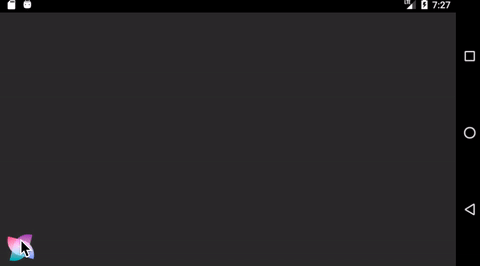MontionLayout:打开动画新世界大门(其一)
前言
本文转载自水月沐风,分享了 MontionLayout 的动画效果,相信对大家有所帮助。
水月沐风的博客地址
https://juejin.im/post/5d595328f265da03c34bfa59
最初接触到 MotionLayout 是在国外知名博客的 Android 专栏上。第一眼见到 MotionLayoutMotionLayout 的外文专栏相关介绍已足够详细,所以本文仅对其进行总结和简单应用。老规矩,正文开始前先上一张图:
简介
由于本文的受众需要有一点 ConstraintLayout 的用法基础,如果你对它并不熟悉,可以先去花几分钟看一下本人之前的译文:带你领略 ConstraintLayout 1.1 的新功能。回到正题,什么是MontionLayout ?很多人可能会对这个名词比较陌生,但如果说到它的前身 — ConstraintLayoutMontionLayout 其实是 Google 在去年开发者大会上新推的布局组件。我们先来看看 Android 官方对于它的定义:
>MotionLayout is a layout type that helps you manage motion and widget animation in your app. MotionLayout is a subclass of ConstraintLayout and builds upon its rich layout capabilities.
简单翻译过来就是:MontionLayout 是一个能够帮助我们在 app 中 管理手势 和控件 动画 的布局组件。它是ConstraintLayout 的子类并且基于它自身丰富的布局功能来进行构建。
当然,你也可以按照字面意思将它简单理解为“运动布局”。为什么这么说呢?通过上图来对比传统的布局组件(如:FrameLayout、LinearLayoutMotionLayout 是布局组件中的一个“里程碑”,由此开始就告别了 XML 文件中只能”静态“操作 UI 的历史。通过MotionLayout,我们就能更加轻易处理其内部子 View 的手势操作和"运动"效果了。正如 Nicolas Roard 所说的那样:
你可以在 MontionLayout 功能方面将其看作是属性动画、TransitionManager 和 CoordinatorLayout 的结合体 。
MotionLayout 基础
首先,我们需要从 MotionLayout 的一些基本属性和用法讲起,这样对于我们后面的实际操作将会很有帮助。
引入 MotionLayout 库
1dependencies {
2 implementation 'com.android.support.constraint:constraint-layout:2.0.0-beta2'
3}
4复制代码
目前,MotionLayout 仍处于 beta 版本,虽然官方之前说过 MotionLayout 的动画辅助工具将会在 betaConstraintLayout
在布局文件中使用 MotionLayout
想要使用 MotionLayout,只需要在布局文件中作如下声明即可:
1<android.support.constraint.motion.MotionLayout
2 xmlns:android="http://schemas.android.com/apk/res/android"
3 xmlns:tools="http://schemas.android.com/tools"
4 xmlns:app="http://schemas.android.com/apk/res-auto"
5 android:layout_width="match_parent"
6 android:layout_height="match_parent"
7 app:layoutDescription="@xml/scene1">
8
9</android.support.constraint.motion.MotionLayout>
10复制代码
由于 MotionLayout 作为 ConstraintLayout 的子类,那么就自然而然地可以像 ConstraintLayoutMotionLayout 的用处可远不止这些。我们先来看看 MotionLayout 的构成:

由上图可知,MotionLayout 可分为 ConstraintLayout,至于 layoutDescription 属性,我们需要为它传入一个 MotionScene 包裹的 XML
MotionScene:传说中的“百宝袋”
什么是 MotionScene?结合上图 MotionScene 主要由三部分组成: StateSet 、ConstraintSet 和 Transition 。为了让大家快速理解和使用 MotionScene,本文将重点讲解ConstarintSet 和 Transition,至于 StateSet
首先,我们从实现下面这个简单的效果讲起:

GIF 画质有点渣,见谅,但从上图我们可以发现这是一个简单的平移动画,通过点击自身(篮球)来触发,让我们来通过 MotionLayout
1<?xml version="1.0" encoding="utf-8"?>
2<android.support.constraint.motion.MotionLayout
3 xmlns:android="http://schemas.android.com/apk/res/android"
4 xmlns:tools="http://schemas.android.com/tools"
5 xmlns:app="http://schemas.android.com/apk/res-auto"
6 android:layout_width="match_parent"
7 android:layout_height="match_parent"
8 app:layoutDescription="@xml/step1"
9 tools:context=".practice.MotionSampleActivity">
10 <ImageView
11 android:id="@+id/ball"
12 android:layout_width="wrap_content"
13 android:layout_height="wrap_content"
14 android:src="@drawable/ic_basketball"/>
15</android.support.constraint.motion.MotionLayout>
16复制代码
布局文件很简单,只不过你可能会注意到,我们对 ImageView 并没有添加任何约束,原因在于:我们会在 MotionScene 中声明ConstraintSet,里面将包含该 ImageView 的“运动”起始点和终点的约束信息。当然你也可以在布局文件中对其加以约束,但MotionScene 中对于控件约束的优先级会高于布局文件中的设定 。这里我们通过 layoutDescription 来为MotionLayout 设置它的 MotionScene 为 step1,接下来就让我们一睹 MotionScene 的芳容:
1<?xml version="1.0" encoding="utf-8"?>
2<!--describe the animation for activity_motion_sample_step1.xml-->
3<MotionScene xmlns:android="http://schemas.android.com/apk/res/android"
4 xmlns:app="http://schemas.android.com/apk/res-auto">
5 <!-- A transition describes an animation via start and end state -->
6 <Transition
7 app:constraintSetStart="@id/start"
8 app:constraintSetEnd="@id/end"
9 app:duration="2200">
10 <OnClick
11 app:targetId="@id/ball"
12 app:clickAction="toggle" />
13 </Transition>
14
15 <!-- Constraints to apply at the start of the animation -->
16 <ConstraintSet android:id="@+id/start">
17 <Constraint
18 android:id="@+id/ball"
19 android:layout_width="48dp"
20 android:layout_height="48dp"
21 android:layout_marginStart="12dp"
22 android:layout_marginTop="12dp"
23 app:layout_constraintStart_toStartOf="parent"
24 app:layout_constraintTop_toTopOf="parent"/>
25 </ConstraintSet>
26
27 <!-- Constraints to apply at the end of the animation -->
28 <ConstraintSet android:id="@+id/end">
29 <Constraint
30 android:id="@+id/ball"
31 android:layout_width="48dp"
32 android:layout_height="48dp"
33 android:layout_marginEnd="12dp"
34 android:layout_marginBottom="12dp"
35 app:layout_constraintEnd_toEndOf="parent"
36 app:layout_constraintBottom_toBottomOf="parent"/>
37 </ConstraintSet>
38
39</MotionScene>
40复制代码
首先,可以发现我们定义了两个 ImageViewMotionLayoutPath
回到上面这个例子,我们只需要为 Transition 设置起始位置和结束位置的 ConstraintSet 并设置动画时间即可,剩下的都交给MotionLayout 自动去帮我们完成。当然你也可以通过 onClick 点击事件来触发动画,绑定目标控件的 id 以及通过clickAction 属性来设置点击事件的类型,这里我们设置的是toggle,即通过反复点击控件来切换动画的状态,其他还有很多属性可以参照官方文档去研究,比较简单,这里就不一一讲解它们的效果了。如此一来,运行一下就能看到上面的效果了。另外,为了方便测试,我们可以给MotionLayout 加上调试属性: app:motionDebug="SHOW_PATH" ,然后就能轻易的查看其动画内部的运动轨迹:

什么?你说这个动画效果太基础?那好,我就来个简陋版的“百花齐放”效果吧,比如下面这样:

首先,让我们分析一下这个效果:仔细看我们可以发现,通过向上滑动蓝色的 Android
1<?xml version="1.0" encoding="utf-8"?>
2<android.support.constraint.motion.MotionLayout
3 xmlns:android="http://schemas.android.com/apk/res/android"
4 xmlns:tools="http://schemas.android.com/tools"
5 xmlns:app="http://schemas.android.com/apk/res-auto"
6 android:layout_width="match_parent"
7 android:layout_height="match_parent"
8 app:motionDebug="SHOW_PATH"
9 app:layoutDescription="@xml/step2"
10 tools:context=".practice.MotionSampleActivity">
11 <ImageView
12 android:id="@+id/ic_android_blue"
13 android:layout_width="42dp"
14 android:layout_height="42dp"
15 android:src="@mipmap/android_icon_blue"/>
16 <ImageView
17 android:id="@+id/ic_android_left"
18 android:layout_width="42dp"
19 android:layout_height="42dp"
20 android:src="@mipmap/android_icon_purple"/>
21 <ImageView
22 android:id="@+id/ic_android_right"
23 android:layout_width="42dp"
24 android:layout_height="42dp"
25 android:src="@mipmap/android_icon_orange"/>
26 <TextView
27 android:id="@+id/tipText"
28 android:text="Swipe the blue android icon up"
29 android:layout_width="wrap_content"
30 android:layout_height="wrap_content"
31 app:layout_constraintEnd_toEndOf="parent"
32 android:layout_marginEnd="16dp"
33 android:layout_marginTop="16dp"
34 app:layout_constraintTop_toTopOf="parent"/>
35</android.support.constraint.motion.MotionLayout>
36复制代码
下面我们来看下 step2 中的 MotionScene:
1<?xml version="1.0" encoding="utf-8"?>
2<!--describe the animation for activity_motion_sample_step2.xml-->
3<!--animate by dragging target view-->
4<MotionScene xmlns:android="http://schemas.android.com/apk/res/android"
5 xmlns:app="http://schemas.android.com/apk/res-auto">
6 <!--At the start, all three stars are centered at the bottom of the screen.-->
7 <ConstraintSet android:id="@+id/start">
8 <Constraint
9 android:id="@+id/ic_android_blue"
10 android:layout_width="42dp"
11 android:layout_height="42dp"
12 android:layout_marginBottom="20dp"
13 app:layout_constraintStart_toStartOf="parent"
14 app:layout_constraintEnd_toEndOf="parent"
15 app:layout_constraintBottom_toBottomOf="parent"/>
16 <Constraint
17 android:id="@+id/ic_android_left"
18 android:layout_width="42dp"
19 android:layout_height="42dp"
20 android:alpha="0.0"
21 android:layout_marginBottom="20dp"
22 app:layout_constraintStart_toStartOf="parent"
23 app:layout_constraintEnd_toEndOf="parent"
24 app:layout_constraintBottom_toBottomOf="parent"/>
25 <Constraint
26 android:id="@+id/ic_android_right"
27 android:layout_width="42dp"
28 android:layout_height="42dp"
29 android:layout_marginBottom="20dp"
30 android:alpha="0.0"
31 app:layout_constraintStart_toStartOf="parent"
32 app:layout_constraintEnd_toEndOf="parent"
33 app:layout_constraintBottom_toBottomOf="parent"/>
34 </ConstraintSet>
35
36 <!--Define the end constraint to set use a chain to position all three stars together below @id/tipText.-->
37 <ConstraintSet android:id="@+id/end">
38 <Constraint
39 android:id="@+id/ic_android_left"
40 android:layout_width="58dp"
41 android:layout_height="58dp"
42 android:layout_marginEnd="90dp"
43 android:alpha="1.0"
44 app:layout_constraintHorizontal_chainStyle="packed"
45 app:layout_constraintStart_toStartOf="parent"
46 app:layout_constraintEnd_toStartOf="@id/ic_android_blue"
47 app:layout_constraintTop_toBottomOf="@id/tipText"/>
48 <Constraint
49 android:id="@+id/ic_android_blue"
50 android:layout_width="58dp"
51 android:layout_height="58dp"
52 app:layout_constraintEnd_toStartOf="@id/ic_android_right"
53 app:layout_constraintStart_toEndOf="@id/ic_android_left"
54 app:layout_constraintTop_toBottomOf="@id/tipText"/>
55 <Constraint
56 android:id="@+id/ic_android_right"
57 android:layout_width="58dp"
58 android:layout_height="58dp"
59 android:layout_marginStart="90dp"
60 android:alpha="1.0"
61 app:layout_constraintStart_toEndOf="@id/ic_android_blue"
62 app:layout_constraintEnd_toEndOf="parent"
63 app:layout_constraintTop_toBottomOf="@id/tipText"/>
64 </ConstraintSet>
65 <!-- A transition describes an animation via start and end state -->
66 <Transition
67 app:constraintSetStart="@id/start"
68 app:constraintSetEnd="@id/end">
69 <!-- MotionLayout will track swipes relative to this view -->
70 <OnSwipe app:touchAnchorId="@id/ic_android_blue"/>
71 </Transition>
72</MotionScene>
73复制代码
上面代码其实很好理解,之前我们定义了一个控件的 Constraint,现在只需要多加两个即可。由于三个 AndroidConstraintLayout 的基础,就不多说了。接着将结束位置的左、右 Android 机器人透明度设置为MotionLayout 会自动处理目标控件 alpha 属性的变化效果,让其看起来依旧丝滑。
另外,我们这里没有再通过 touchAnchorId 为蓝色小机器人即可,怎么样,是不是有种“拍案惊奇”的感觉。此外,你可以通过指定 touchAnchorSide 和dragDirection
到这里,你可能会说:前面两个示例的动画轨迹一直是"直线",如果想要某段动画过程的轨迹是"曲线"效果可以吗?当然没问题! Keyframes
KeyFrameSet:让动画独树一帜
如果我们想实现“独树一帜”的动画交互效果,那就离不开 KeyFrameSet

以大家的慧眼不难发现:风车的运动轨迹为曲线,并且旋转并放大至中间位置时会达到零界点,然后开始缩小。布局代码就不上了,很简单,里面唯一重要的就是我们需要实现的step3.xml 了:
1<?xml version="1.0" encoding="utf-8"?>
2<!--describe the animation for activity_motion_sample_step3.xml-->
3<!--animate in the path way on a view-->
4<MotionScene xmlns:android="http://schemas.android.com/apk/res/android"
5 xmlns:app="http://schemas.android.com/apk/res-auto">
6 <!-- Constraints to apply at the start of the animation -->
7 <ConstraintSet android:id="@+id/start">
8
9 <Constraint
10 android:id="@id/windmill"
11 android:layout_width="40dp"
12 android:layout_height="40dp"
13 android:layout_marginStart="12dp"
14 android:layout_marginBottom="12dp"
15 app:layout_constraintStart_toStartOf="parent"
16 app:layout_constraintBottom_toBottomOf="parent"/>
17
18 <Constraint
19 android:id="@id/tipText"
20 android:layout_width="wrap_content"
21 android:layout_height="wrap_content"
22 android:alpha="0.0"
23 app:layout_constraintStart_toStartOf="parent"
24 app:layout_constraintBottom_toBottomOf="@id/windmill"
25 app:layout_constraintTop_toTopOf="@id/windmill"/>
26 </ConstraintSet>
27 <!-- Constraints to apply at the end of the animation -->
28 <ConstraintSet android:id="@+id/end">
29 <!--this view end point should be at bottom of parent-->
30 <Constraint
31 android:id="@id/windmill"
32 android:layout_width="40dp"
33 android:layout_height="40dp"
34 android:layout_marginBottom="12dp"
35 android:layout_marginEnd="12dp"
36 app:layout_constraintEnd_toEndOf="parent"
37 app:layout_constraintBottom_toBottomOf="parent"/>
38 <Constraint
39 android:id="@+id/tipText"
40 android:layout_width="wrap_content"
41 android:layout_height="wrap_content"
42 android:layout_marginBottom="12dp"
43 android:alpha="1.0"
44 android:layout_marginEnd="72dp"
45 app:layout_constraintEnd_toEndOf="parent"
46 app:layout_constraintBottom_toBottomOf="parent"/>
47 </ConstraintSet>
48
49 <!-- A transition describes an animation via start and end state -->
50 <Transition
51 app:constraintSetStart="@id/start"
52 app:constraintSetEnd="@id/end">
53
54 <KeyFrameSet>
55 <KeyPosition
56 app:framePosition="50"
57 app:motionTarget="@id/windmill"
58 app:keyPositionType="parentRelative"
59 app:percentY="0.5"/>
60 <!--apply other animation attributes-->
61 <!--前半段的动画效果:逆时针旋转一圈,同时放大一倍-->
62 <KeyAttribute
63 app:motionTarget="@id/windmill"
64 android:rotation="-360"
65 android:scaleX="2.0"
66 android:scaleY="2.0"
67 app:framePosition="50"/>
68 <!--后半段的动画效果:逆时针旋转一圈,同时变回原样-->
69 <KeyAttribute
70 app:motionTarget="@id/windmill"
71 android:rotation="-720"
72 app:framePosition="100"/>
73 <!--延迟动画——0-85过程中将透明度一直维持在0.0-->
74 <KeyAttribute
75 app:motionTarget="@id/tipText"
76 app:framePosition="85"
77 android:alpha="0.0"/>
78 </KeyFrameSet>
79
80 <OnSwipe
81 app:touchAnchorId="@id/windmill"
82 app:touchAnchorSide="bottom"
83 app:dragDirection="dragRight"/>
84 </Transition>
85
86</MotionScene>
87复制代码
从上述代码我们可以发现:KeyFrameSet 需要被包含在 Transition 里面,同时 KeyFrameSet 中定义了KeyPosition 用于指定动画某个关键帧的位置信息,而 KeyAttributeKeyFrameSet 中还支持
我们先来看下 KeyPosition 的构成:

从上图可见,keyPositionType 一共有三种,本文使用的是 parentRelative,即以整个 MotionLayoutframePosition 属性来 指定关键帧所在的位置 ,取值范围为 0 - 100,本示例中设置的 50percentX 和 percentY 来设置该关键帧位置的偏移量,它们取值一般为 0 — 1,当然也可以设置为负数或者大于一,比如,本示例中如果没有设置偏移量,那么动画的轨迹无疑是一条平行于 x 轴的直线,但通过设置app:percentY="0.5",那么风车就会在动画中点位置向 y 轴方向偏移一半的高度,即下图的效果(开始 debug 模式):

可能会有人问了:为什么轨迹不是三角形,而是曲线呢?哈哈,这个问题问得好!因为 MotionLayout
了解完 KeyFrameSet 的用法,那么我们就很轻易的实现下面这个效果啦:

代码就不贴了,MotionLayout 系列代码都会上传至 GitHub
本文全部代码:github.com/Moosphan/Co…
最后
本文的出发点是希望仅仅为大家提供一个“钥匙孔”的角色,通过这个“孔”,大家可以依稀看见门里“宝藏”的余光,想要打开门寻得宝藏,就需要大家"事必躬亲",拿到“钥匙”来打开这扇门了。当然,大家也可以继续关注我的后续之作,来发现更多MontionLayout 的宝藏。
推荐阅读
Android 面试必备 - 知识图谱
致刚入职场的你 - 程序员的成长笔记
干起来,你就超过了 50% 的人
一个程序员的五年总结,给你不一样的角度
Fragment全解析系列(一):那些年踩过的坑
Fragment全解析系列(二):正确的使用姿势
带你全面了解 Android 内存优化
Android自定义控件进阶篇,自定义LayoutManager
策略模式 — 孔明排兵布阵
 stormjun94
stormjun94
扫一扫,欢迎关注我的公众号 stormjun94。如果你有好的文章,也欢迎你的投稿。